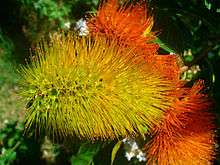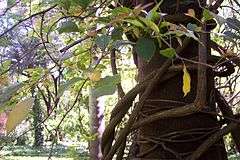Combretum fruticosum
| Orange flame vine | |
|---|---|
 | |
| Scientific classification | |
| Kingdom: | Plantae |
| (unranked): | Angiosperms |
| (unranked): | Eudicots |
| (unranked): | Rosids |
| Order: | Myrtales |
| Family: | Combretaceae |
| Genus: | Combretum |
| Species: | C. fruticosum |
| Binomial name | |
| Combretum fruticosum (Loefl.) Stuntz | |
| Synonyms | |
|
Combretum farinosum Kunth[1] | |
Combretum fruticosum, known as orange flame vine or chameleon vine, is a species of bushwillow that occurs from Mexico to northern Argentina.[1]

Description
The orange flame vine is a liana that reaches up to 3 metres (9.8 ft) in height without a support and up to 11 metres (36 ft) with a support. The branches are cylindrical and striated.
The leaves are persistent to semipersistent, dense and dry. They are simple, opposite, sometimes alternate, 6 to 16 cm long and 3 to 8 cm broad, with an entire margin and a short petiole.
The flowers appear in summer and are yellowish to reddish, small, grouped in axillar spikes 8 to 16 cm long. The calyx is bell-shaped with 4 lobules 5 mm long, the corolla has 4 very small petals 1 to 1.5 mm long. The 8 stamens are 3 cm long and have reddish anthers. The number of flowers varies from 52 to 93 in each inflorescence.[1]
The fruit forms in autumn and is dry and indehiscent, 2 cm long, and reddish brown.
References
- 1 2 3 Bernardello, Luis; Galetto, Leonardo; Rodriguez, Ivana G. (1994). "Reproductive biology, variability of nectar features and pollination of Combretum fruticosum (Combretaceae) in Argentina". Botanical Journal of the Linnean Society. 114 (3): 293–308. doi:10.1111/j.1095-8339.1994.tb01938.x. ISSN 0024-4074.
Bibliography
- USDA, ARS, National Genetic Resources Program.
Germplasm Resources Information Network - (GRIN) National Germplasm Resources Laboratory, Beltsville, Maryland. http://www.ars-grin.gov/cgi-bin/npgs/html/taxon.pl?11225 (21 nov. 2007)